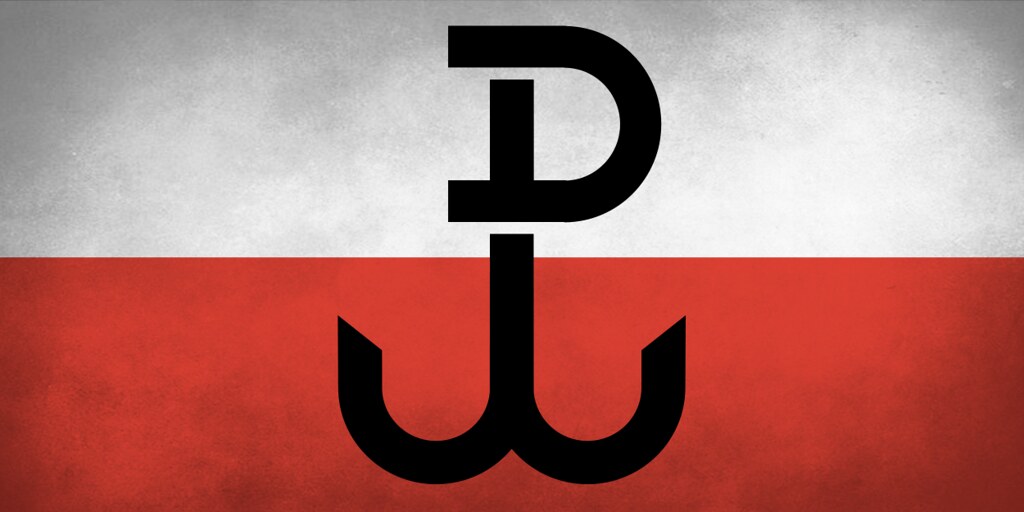Three Videos that Show You How Poland Remembers the Heroes Mentioned by Trump
On Thursday, during the formidable speech he delivered in Warsaw, Donald Trump turned to applaud war veterans whom he described as "heroes." Do you know who they were?
A city that stops completely at five in the afternoon
If you walk or drive through Warsaw any August 1 you can find a surprising situation: at five o'clock in the afternoon powerful alarms start to sound and the whole city stops. People stop walking. Drivers stop their vehicles. In armbands, in flags, in T-shirts and in different places this symbol is seen:

It is the "kotwica", the emblem of Armia Krajowa, the main organization of the Polish resistance in World War II. At that hour when everybody stops, and that the Varsovians know as "the W-hour," the Warsaw Uprising against the Nazis began on August 1, 1944. At the end of the minute silence, the crowd begins to scream: "Cześć i chwała bohaterom!" (Honor and glory to the heroes). In this video we see the minute of silence of the last year, in which participated veterans of the Uprising who could not contain the tears before the memory of their loved ones who died in those days of struggle and of pain:
The 'Paris of the East', turned into a ghost town
In 1939 Warsaw was a beautiful city of about 900,000 inhabitants, called the East Paris. Between 150,000 and 200,000 Varsovians perished in the fighting of the Uprising or were massacred by the Nazis. 16,000 Armia Krajowa fighters fell into the fighting during the two months of the Uprising, and 15,000 were taken prisoner. More than half a million Varsovians were forced to flee their homes. Warsaw was in ruins, almost completely devastated by the Germans, who were thoroughly employed - by means of explosives and flamethrowers - not to leave stone on stone. When the Red Army arrived on January 17, 1945, only 15% of its buildings remained: Warsaw was a ghost town.
The young postman scout
The Warsaw Uprising Museum has encouraged the Varsovians to accompany the veterans at that W-time. The campaign consists of two spots. In the first a veteran attends the tribute to the Uprising on August 1. He is already old and walks with difficulty, and suddenly finds a warning in the elevator of his building: "Winda nieczynna z powodu awarii" (lift out of service due to a failure). He is unable to go down the stairs, and at that moment a postman collides with him. The old man drops a picture of a young postman of the Uprising (the insurgents set up their own post office that used as mailmen to scout boys). You can see in the video what happens next:
The young 'sanitariuszka'
In the second spot we see an old woman in a hospital. A nurse goes to her room. Leaving a tray on her nightstand, she drops a picture of a young woman from the Warsaw Uprising. These sanitarians (including young girls) not only helped to heal the wounded, but also provided encouragement and comfort in these difficult times. The old lady gives the nurse a cloth object. The girl opens it. It is almost five o'clock in the afternoon, and she goes to warn her companions. You can see in the video what happens next:
The veterans of the Uprising are direct witnesses to the horror of that war. Those who have always lived in a society in peace can not imagine the things they saw. Their memory keeps alive the example of sacrifice and heroism that led them and their compatriots to rebel against Nazi oppression. Serve this post as a homage to the Polish patriots who fought for their freedom and ours.
Cześć i chwała bohaterom!
|
Don't miss the news and content that interest you. Receive the free daily newsletter in your email: Click here to subscribe |
- Most read
- The 'hole' without civil flights around Paris during the opening of the Olympic Games
- Spain vetoes the Russian frigate 'Shtandart', which intended to reach Vigo, in all its ports
- The interior of the Statue of Liberty torch and the sabotage that canceled its visits
- The ten oldest national flags in the world that are still in use today
- The BNG boasts of the support of a terrorist group and a dictatorship at a public event
- The Russian intelligence document that sparked a hoax about French troops
- A virtual tour of ancient Rome in full color, just as it was in its heyday

 ES
ES





Opina sobre esta entrada: